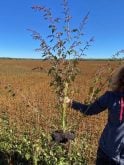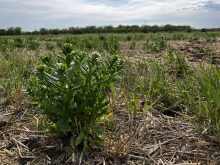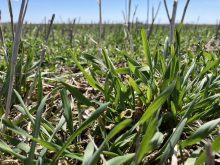Manitoba’s spring weather may have set weeds back, but the spray season hasn’t been a picnic for farmers either.
Provincial weed specialist Tammy Jones warns that producers might be in for a tough weed control season, despite cool temperatures and dry conditions keeping weeds from gaining ground early this year.
Why it matters: Clean fields this spring may have been a smokescreen for challenging weed control conditions now that the season is underway.
“The right weather this year might be a challenge for a number of reasons: dry conditions, the heat, now something that looks like a frost event for some,” Jones said. “It’s going to be a challenge, but we have to try and do the best that we can.”
Read Also

CUSMA access key among other trade noise: Seeds Canada panel
Seeds Canada conference panelists say Canada needs to stay focused and wait as U.S. trade and tariff chaos develops, and a Canada-U.S.-Mexico Agreement review looms
Smaller is always better when it comes to staging weeds for control, most experts warn, but farmers noted a distinct lack of weeds this spring, leading some to question their pre-seed burn-off when added to lack of rain and tough growing conditions for the crop.
Farmers were unsure if they wanted to spend the money on a crop that may not germinate well, Jones said back in May, noting that those farmers may have forgone that risk in favour of in-crop control.
Farmers with poor stands and little competition with weeds may now be fighting the results of that decision.
“I’m not looking forward to trying to get guys through the challenges that I think they’ve set themselves up for by skipping that pre-seed burn,” she said after a May 29 weed seedling identification day in Brandon.
- Read more: Dry year adds to spray considerations
Jones was still seeing late-emerging green foxtail at the one-leaf stage at that time, she noted, while dandelion and stinkweed had not been controlled in some fields and had already matured into flowering and largely past the label for chemical control.
Delayed weeds complicated the decision of whether to do a burn-off, sprayer specialist Tom Wolf said. Wolf is one of the leads at Saskatchewan spray company Agrimetrix, as well as one of the main voices behind the blog sprayers101.com.
At the same time, he said, the decision to hold off on spray is “a perfectly sound decision” when few weeds are up.
“The weeds do have to be present and the question is, if there are only a few present, is it worth spraying? What’s the cost of letting those big weeds, or those present that will be big after seeding, survive? What are the yield implications or other implications of that?” he said.
Frost, wind and woes
Those who did want to spray may have had little luck.
A string of frost events chipped away at herbicide efficacy in late May and early June. Temperatures widely dropped below zero May 26-27, while the east Interlake and parts of central Manitoba woke up to yet more frost June 2. Parts of the northwest and Interlake saw yet another frost June 12, dipping to -1.3 C in Fisher Branch.
Frost events were spaced out just enough that weeds had started to recover and spraying could get underway again, when the next frost would hit, Wolf noted.
“You need to spray, everything else is relying on you to get that pre-seed burn-off done because the seeder’s moving and you can’t stay ahead of the seeder and that has a cascading effect,” he said.
Both Jones and Wolf noted added challenge from the lack of rain. Weeds may be drought hardened, Wolf noted, while Jones pointed out that the weeds may be adjusting to the dry conditions, such as folding up leaves, something that reduces herbicide contact as liquid rolls off.
“I would say that dry conditions are amongst the most challenging that agronomists and farmers ever have because, in the first place, the herbicide mode of action requires a vigorous crop to be present as well,” Wolf said. “In the drought that we’re currently experiencing, that’s not happening, so then a greater reliance is placed on the herbicide to work well to control those weeds. In the second place, the drought does make it more difficult to control those weeds because they’ve also responded to the dry conditions and protected themselves and become a little bit tougher.”
Farmers may need to respond with higher herbicide rates, he added.
Some farmers may hold off for rain, afraid of missing a second flush, he said.
“That, of course, makes the weeds bigger, the ones that are present,” he said. “It actually results in potential yield loss because early removal is a key component of good weed management. These things all kind of roll into one big weed control problem in drought years.”
Time for tank mixes?
Dwayne Durand, manager of Shur-Gro Farm Services in Brandon, says his clients are applying about the same amount of herbicide as in previous years, but are looking for cheaper options.
“The application rates are normal,” he said. “The selection of products might be more highly investigated to see if there’s an opportunity to lower cost. But they’re not cutting corners; they’re just looking at alternative products.”
Farmers have also shown less interest in manufacturer programming, he said.
He has also seen no dramatic increase in the demand for adjuvants, despite weather-driven impacts on herbicide efficacy, he said.




















